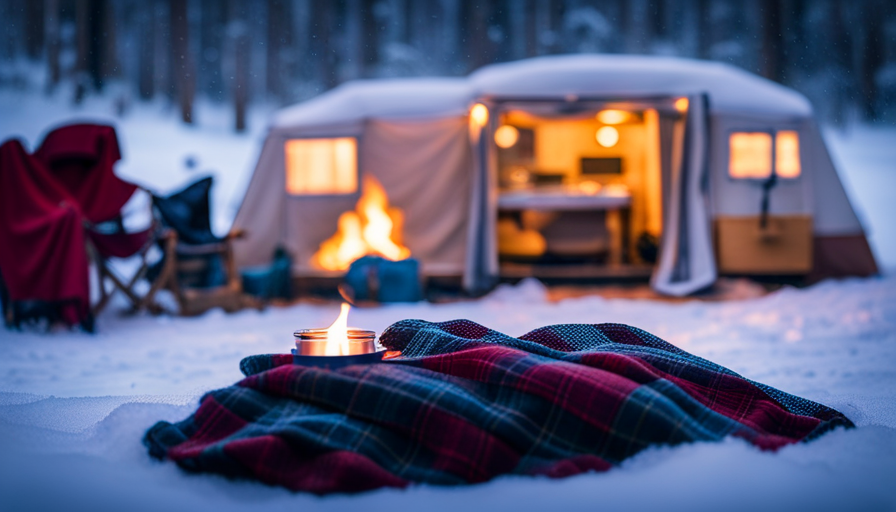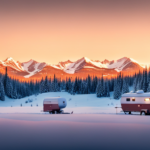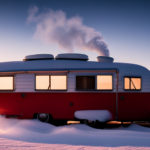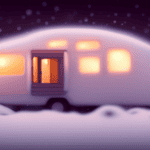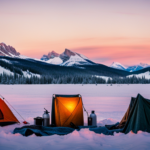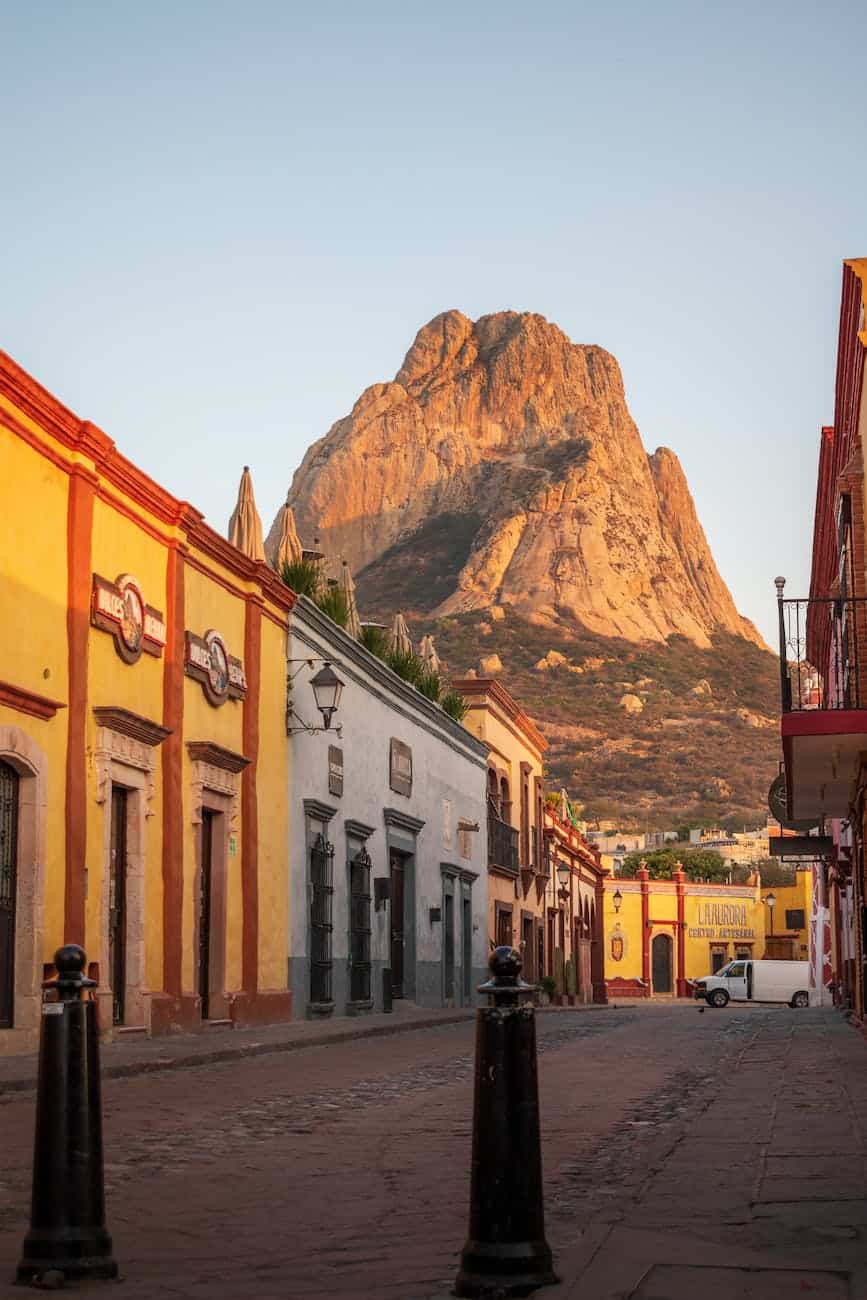Are you ready to embark on a winter adventure in your RV? As the cold weather approaches, it’s important to ensure your RV is properly prepared for winter to stay warm, comfortable, and safe.
In this article, we will guide you through the essential steps to winterize your camper while living in it.
First and foremost, we’ll show you how to insulate your camper effectively, creating a cozy haven against the winter chill. We’ll also teach you how to seal any drafts or leaks that may compromise your comfort. Additionally, we’ll explain the importance of installing skirting around your camper to provide an extra layer of insulation.
We won’t stop there! Our comprehensive guide will cover the use of space heaters and electric blankets, as well as how to protect your pipes and water systems from freezing. We’ll also emphasize the significance of maintaining proper ventilation.
Furthermore, we’ll provide invaluable tips on stocking up on essential supplies and monitoring propane levels. Finally, we’ll ensure you’re prepared for any emergencies that may arise during your winter camping experience.
So, grab a cup of hot cocoa and get ready to transform your camper into a winter wonderland!
Key Takeaways
- Insulate windows and walls with bubble wrap or insulating foam boards.
- Use foam mats or rugs on the floors for extra insulation.
- Install insulating curtains or thermal blinds to minimize heat loss through windows.
- Seal drafts and leaks with weatherstripping tape, caulk, or expanding foam.
Insulate the Camper
You’ll want to start by insulating your camper to create a cozy and warm retreat from the chilly winter air. By implementing energy-efficient insulation methods, you can effectively retain heat and keep the cold out.
One of the most cost-effective ways to insulate your camper is by using bubble wrap. Simply attach it to your windows with double-sided tape, creating an extra layer of insulation.
Another option is to use insulating foam boards. Cut them to fit the walls and ceiling of your camper, then attach them with adhesive. This method provides excellent insulation and helps to reduce condensation.
For the floors, consider using foam mats or rugs to provide an extra layer of insulation. They not only keep your feet warm but also help to prevent heat loss through the floor.
Additionally, insulating curtains or thermal blinds can be a great investment to minimize heat loss through windows.
When it comes to DIY camper insulation tips, make sure to seal any drafts or leaks. Use weatherstripping tape to seal gaps around windows and doors. Inspect your camper thoroughly for any cracks or holes and seal them with caulk or expanding foam.
By insulating your camper and sealing any drafts or leaks, you’ll be well on your way to creating a warm and cozy space to enjoy the winter season.
Seal any Drafts or Leaks
To ensure a cozy and well-insulated space, addressing any drafts or leaks should be a top priority when preparing your mobile home for the colder months. Start by inspecting all windows for any gaps or cracks that could allow cold air to seep in. Weatherstrip windows with adhesive to create a tight seal when closed. Additionally, caulk any gaps or cracks around windows to prevent cold air from entering. Use a waterproof and weather-resistant caulking compound for best results.
Next, check for any other potential sources of drafts or leaks, such as around doors or vents. Apply weatherstripping to the edges of doors and ensure a snug fit when closed. Use sealant or caulk to fill any gaps or cracks around vents or other openings in the camper.
By properly weatherstripping windows and caulking gaps, you can significantly reduce drafts and keep your camper well-insulated during the winter months. This will help maintain a comfortable living space and prevent heat loss.
In the next section, we’ll discuss the importance of installing skirting around the camper to further enhance insulation and protect against cold temperatures.
Install Skirting Around the Camper
Enhance the coziness and insulation of your mobile home by installing skirting around the camper. Skirting provides a barrier between the ground and the underside of the camper, preventing cold air from seeping in and warm air from escaping. This not only keeps you warm and comfortable during the winter months but also helps to reduce heating costs.
Here are some benefits of skirting and tips for installing it:
- Improved insulation: Skirting creates a thermal barrier, reducing heat loss and keeping the interior of your camper warmer.
- Protection from pests: Skirting helps to keep out unwanted visitors like rodents and insects, preventing them from entering your living space.
- Enhanced aesthetics: Skirting gives your camper a finished look, improving its overall appearance.
- Added storage space: Some skirting options include access doors, allowing you to store items underneath your camper.
When installing skirting, ensure that it’s securely attached to the camper and that there are no gaps or openings. Consider using insulation materials such as foam boards or weather-resistant fabrics to maximize the skirting’s effectiveness. Additionally, leave a small ventilation gap to prevent moisture buildup.
By installing skirting around your camper, you can create a comfortable and well-insulated living space for the winter.
In the next section, we’ll explore how to further enhance warmth using space heaters or electric blankets.
Use Space Heaters or Electric Blankets
Keep cozy during the colder months by utilizing space heaters or electric blankets in your mobile home. When it comes to using space heaters safely, there are a few important things to keep in mind.
First, make sure to choose a heater that’s specifically designed for indoor use. This will help prevent any potential safety hazards. Additionally, always keep flammable materials, such as curtains or blankets, at least three feet away from the heater to reduce the risk of a fire. It’s also crucial to never leave the space heater unattended and to turn it off when you leave the room or go to sleep.
Now, let’s talk about electric blankets. They can be a great option for staying warm during the winter months. One of the major advantages of electric blankets is that they provide direct heat to your bed, keeping you warm and cozy throughout the night. They’re also energy-efficient, as you can use them to heat only the area you need, rather than heating the entire camper. However, it’s important to follow the manufacturer’s instructions and never leave the electric blanket on for an extended period of time, especially when you’re not using it.
Transitioning into the next section about protecting pipes and water systems from freezing, it’s crucial to take additional precautions to ensure your camper is winterized effectively.
Protect Pipes and Water Systems from Freezing
Another important step in ensuring the functionality of our mobile home during the colder months is protecting the pipes and water systems from freezing. Freezing temperatures can cause pipes to burst, leading to costly repairs and water damage.
To prevent freezing, it’s crucial to winterize the plumbing in our camper. Firstly, we need to locate all the water lines and pipes in our camper. This includes both the supply lines and the drain lines. Once located, we should insulate them using foam pipe insulation or heat tape. These materials provide a layer of insulation that helps maintain the temperature of the water inside the pipes.
Next, we should disconnect and drain all the water hoses and faucets. Any remaining water in these areas can freeze and cause damage. It’s also important to drain the water tanks and hot water heater, as these can also freeze and crack.
Lastly, we should consider using an RV antifreeze in our water systems. This non-toxic solution helps prevent freezing by lowering the freezing point of the water. We should follow the manufacturer’s instructions when using RV antifreeze.
By taking these steps to prevent freezing and winterize our plumbing, we can ensure the functionality of our mobile home during the winter months.
Another way to protect our camper from the cold is by using reflective window coverings. These coverings help insulate the windows and keep the cold air out.
Use Reflective Window Coverings
To maximize insulation and keep the cold air out, make sure you utilize reflective window coverings in your mobile home during the winter months. Reflective window coverings offer several benefits when it comes to winterizing your camper. Here are three key advantages:
-
Increased Insulation: Reflective window coverings create a barrier that helps to trap heat inside your camper. They reflect the cold air and prevent it from entering through the windows, keeping the interior warmer and reducing the need for constant heating.
-
Energy Efficiency: By keeping the cold air out and the warm air in, reflective window coverings can significantly improve the energy efficiency of your camper. This can result in lower heating costs and a reduced environmental footprint.
-
UV Protection: Reflective window coverings also block harmful UV rays from entering your camper. This not only protects your skin and eyes, but it also helps to prevent fading and damage to your furniture, curtains, and other interior elements.
When choosing reflective window coverings, consider the following tips:
- Look for window coverings specifically designed for insulation and energy efficiency.
- Opt for coverings that have a reflective coating on one side to maximize their insulating properties.
- Ensure that the coverings fit snugly over your windows to prevent any gaps where cold air can seep in.
By using reflective window coverings, you can effectively winterize your camper and create a cozy living space. However, it’s important to keep ventilation open to prevent condensation and maintain a healthy indoor environment.
Keep Ventilation Open
Make sure you don’t overlook the importance of keeping ventilation open in your mobile home during the winter months – it’s essential for maintaining a fresh and healthy environment that you’ll love coming home to. Proper ventilation is crucial for humidity control and condensation prevention, both of which are important factors in winterizing your camper.
When the temperature drops outside, the warm air inside your camper can lead to increased humidity levels. Without proper ventilation, this excess moisture can accumulate on windows, walls, and other surfaces, creating the perfect breeding ground for mold and mildew. Additionally, condensation can cause wood rot, rust, and other structural damage.
To prevent these issues, make sure to keep your vents open and clear of any obstructions. You can use vent covers to protect against rain or snow while still allowing for airflow. Installing a dehumidifier can also help regulate humidity levels inside your camper. It’s important to note that while ventilation is crucial, you should also insulate your camper properly to prevent heat loss. By maintaining a balance between ventilation and insulation, you can create a comfortable and healthy living space throughout the winter months.
With ventilation taken care of, the next step is to stock up on essential supplies to ensure you’re fully prepared for winterizing your camper.
Stock up on Essential Supplies
Don’t forget to gather all the necessary supplies to ensure you’re fully equipped for the winter season in your mobile home, so you can cozy up and weather the storm with ease. As you prepare your camper for winter, it’s important to have a winterizing checklist in mind.
Stock up on essential supplies such as insulation materials, window covers, and draft stoppers. Insulating your camper will help keep the cold air out and the warm air in, making it easier to stay warm in a camper during the winter months.
In addition to insulation, make sure to have plenty of blankets, warm clothing, and bedding to keep yourself comfortable during colder nights. It’s also a good idea to have a portable heater or electric blanket as a backup heat source.
Another important item to have on hand is a good supply of non-perishable food and drinking water. Winter storms can cause power outages, so having enough food and water to last for a few days is essential. Additionally, make sure to have a stocked first aid kit in case of any emergencies.
Transitioning into the subsequent section about monitoring propane levels, it’s crucial to keep track of your propane supply throughout the winter season.
Monitor Propane Levels
Monitoring your propane levels is crucial during the winter season to ensure you have enough fuel to keep your mobile home warm and cozy. Propane is the primary source of heat for most campers, making it essential to keep track of how much you have left.
To monitor propane usage, you should regularly check the propane gauge or meter. This will give you an accurate reading of how much propane is remaining in your tank. Additionally, consider investing in a propane level indicator, which attaches to the tank and provides a more precise measurement.
Safety precautions should also be taken when monitoring propane levels. Always inspect the tank and connections for any signs of leaks or damage. If you suspect a leak, turn off the propane supply immediately and seek professional assistance. It’s also important to keep the tank in a well-ventilated area and away from any flammable materials.
Monitoring your propane levels ensures that you have enough fuel to keep your camper warm and cozy during the winter months. By regularly checking your propane gauge or meter and taking necessary safety precautions, you can prevent any potential hazards and stay prepared for emergencies such as running out of propane.
Stay Prepared for Emergencies
Being prepared for emergencies is essential to ensure the safety and comfort of your mobile home, especially during the winter months. Winter weather can be unpredictable, so it’s important to have a plan in place and be equipped to handle any potential emergencies that may arise.
Here are four key steps to stay prepared for emergencies and maintain winter safety in your camper:
-
Create an emergency kit: Put together a well-stocked emergency kit that includes essential items such as flashlights, batteries, a first aid kit, non-perishable food, water, blankets, and a portable heater. This kit should be easily accessible and regularly checked to ensure everything is in working order.
-
Install carbon monoxide and smoke detectors: Carbon monoxide and smoke detectors are crucial for detecting potential hazards in your camper. Make sure to install them in appropriate locations and test them regularly to guarantee they’re functioning correctly.
-
Develop an emergency communication plan: Establish a communication plan with your family or fellow campers in case of an emergency. This plan should include designated meeting points, emergency contact numbers, and a way to communicate with others if cell service is limited.
-
Stay informed about weather conditions: Keep an eye on weather forecasts and be aware of any potential winter storms or extreme weather conditions. This will allow you to take necessary precautions and make informed decisions about your safety and well-being.
By following these steps and being proactive in your emergency preparedness, you can ensure a safer and more comfortable winter living experience in your camper.
Frequently Asked Questions
Can I still use my camper’s water system during the winter?
Yes, we can still use the camper’s water system during the winter by using a portable water tank. This allows us to have access to water without risking damage to the camper’s plumbing system.
Additionally, considering alternative heating options is crucial to prevent freezing pipes. By using insulation, heat tape, and space heaters, we can keep the camper’s interior warm and ensure the water system functions properly throughout the winter season.
How do I prevent condensation from forming inside my camper?
To prevent condensation from forming inside our camper, we take several measures. Firstly, we ensure proper ventilation by opening windows or using a dehumidifier.
Secondly, we insulate the camper walls with materials like foam insulation or reflective foil. This helps to maintain a consistent temperature and reduce the chances of condensation.
Additionally, we use moisture-absorbing products like desiccants to further combat humidity buildup. These steps are essential for a comfortable and dry living environment during the winter.
Is it safe to use a propane heater inside the camper?
Using a propane heater inside your camper? Oh, absolutely! It’s a fantastic idea…if you want to risk carbon monoxide poisoning and potentially turn your cozy home-on-wheels into a ticking time bomb.
But fear not, there are safer options for keeping warm during winter camping adventures. Consider electric heaters with safety features, like tip-over shut-offs and temperature controls. Or, invest in a catalytic heater, which operates on safe low-level combustion.
Stay warm, stay alive!
What should I do if my camper’s pipes freeze?
To thaw frozen camper pipes, we must first identify the signs of frozen pipes. These include lack of water flow, low water pressure, and unusual sounds coming from the pipes.
To address this issue, we need to locate the frozen section and apply heat. This can be done with a hairdryer, heat tape, or by using a portable space heater. It’s crucial to avoid using an open flame or excessive heat, as it may damage the pipes.
How can I keep my camper’s batteries from draining in cold weather?
To prevent your camper’s batteries from draining in cold weather, there are a few things you can do. Firstly, insulate your camper windows to minimize heat loss. This can be done using thermal curtains or window insulation film.
Secondly, consider alternative heating options for campers, such as a propane heater or a wood-burning stove. These options can provide sufficient warmth without relying solely on the camper’s battery-powered heating system. Remember to always follow safety guidelines when using alternative heating sources.
Conclusion
In conclusion, winterizing a camper while living in it isn’t a small task. It requires careful planning, attention to detail, and a bit of resourcefulness.
As we seal the drafts, insulate the walls, and install skirting, we create a cozy haven that protects us from the biting cold outside. With space heaters and electric blankets, we can snuggle up and enjoy the warmth within.
By monitoring propane levels and staying prepared for emergencies, we ensure our safety and peace of mind. So let’s embrace the winter wonderland outside, knowing that our camper is a haven of comfort and security.

